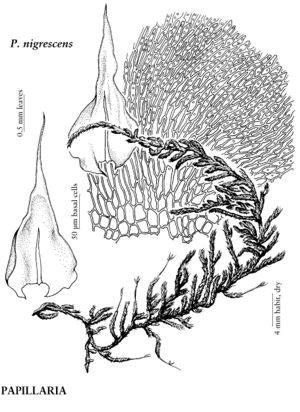Papillaria
Moosstudien, 165. 1864.
| Taxon | Illustrator ⠉ | |
|---|---|---|
 | Papillaria nigrescens | Patricia M. Eckel |
Plants medium-sized, yellowish or black [green or brownish]. Stems densely foliate, irregularly branched to subpinnate, branches short, erect, and densely foliate, or elongate, pendent, and terete-foliate; axillary hair proximal cells 1 or 2, short, light-brown, distal cells 2 or 3, short. Stem-leaves imbricate, lanceolate-acuminate; base ± auriculate; margins plane or recurved distally, papillose-denticulate; costa slender; alar cells differentiated; medial laminal cells short-linear, in rows diverging from costa, seriate-papillose. Branch leaves imbricate; apex sometimes 1-seriate, filiform. Sexual condition apparently dioicous. [Capsule immersed or exserted, oblong-ovoid; operculum rostrate; exostome and endostome papillose, cilia inconspicuous. Calyptra usually hairy. Spores papillose].
Distribution
Nearly worldwide, tropical and subtropical regions
Discussion
Species ca. 80 (1 in the flora).
W. R. Buck (1994) proposed merging Papillaria with a related genus, Meteorium, but Papillaria can be defined adequately by the combination of terete-foliate stems and branches, concave leaves with auriculate bases, seriately multipapillose laminal cells in rows diverging from the costa, and a tendency toward recurved distal leaf margins.
Selected References
None.